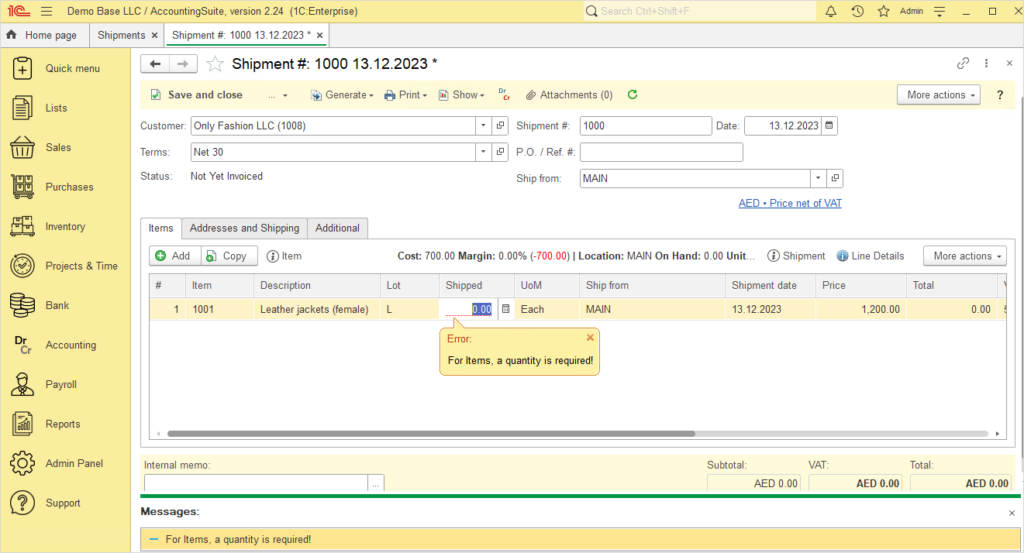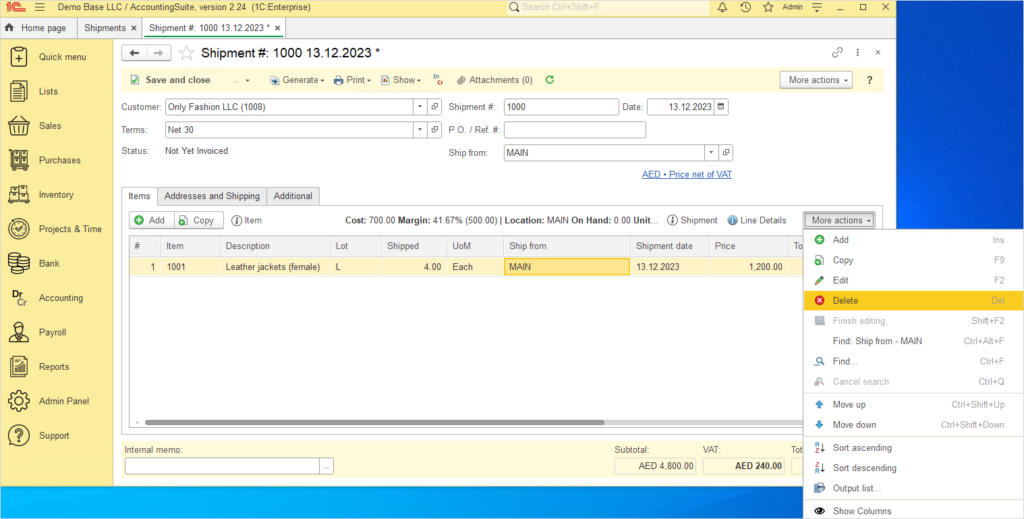The Shipment document is used to record the acknowledgement receipt of goods shipped to a customer. In the Sales flow, this document follows the Sales order and precedes the Sales invoice. When posted, the Shipment document updates inventory by decreasing the Quantity on Hand by the amount specified in the shipment.
Enabling Shipments #
To use Shipments, it must be enabled.
- Navigate to Settings → Sales Settings.
- Check the checkbox labeled Use Shipments.

Create Shipment #
- Ensure that the checkbox labeled Use Shipments is checked on the Sales Order.
- From the Sales Order, choose Generate → Shipment.
- Enter the Shipment #.
- Enter a PO / Ref # if applicable.
- Click the Addresses tab, verify the Ship To: and the Bill To: addresses and enter a Confirm To contact (optional).
- On the Shipping tab, enter the Carrier, the Tracking Number and FOB. (optional).
- On the Project and Class tab, enter a Project and a Class (optional).
- If this is a dropshipped order, click the Dropship tab and enter a Dropship Customer, a Ship To and a Bill To address, and a Confirm To contact, if applicable.
- Change the quantities shipped on the line items if they differ from those on the sales order.
Emailing a Shipment #
The packing list for the shipment may be emailed by clicking the email button. A preview window will appear with a place to enter the to and cc addresses along with a space to add a note to the body of the email. The packing list will be attached as a PDF to the email.
Shipment Status Definitions #
Shipment statuses are as follows:
- Draft – shipment has been created but is not yet finished.
- Not Yet Invoiced – shipment has not yet been invoiced.
- Partially Invoiced – some items on the invoice have been invoiced.
- Invoiced – all items on the invoice have been invoiced.
Under and Over-Shipping #
There may be times when you ship more or less than the quantity on the original Sales Order. The system will allow for over and under-shipping on both the shipment and the Sales invoice, so there is no need to change the original quantity on the Sales Order in this event.
Under-shipping is when the total quantity shipped on the shipment or the Sales invoice is less than originally ordered on the Sales Order and there is no plan to ship the balance. In this case, close the Sales Order by clicking the Status and choosing Closed.
Over-shipping is when the total quantity shipped exceeds the original quantity ordered on the Sales Order and there is no plan for your customer to return the excess. In this case, indicate the quantity received on the Shipment or the Sales invoice and the Sales Order will close automatically.
Accounting #
Recording a Shipment creates the following transactions in the General Journal:
- Debits: Inventory shipped not yet invoiced
- Credits: Inventory
Visual Status Indicators #
The status indicators in AccountingSuite help users gain a clear overview of the order processing stages within both sales and purchase cycles. By simply glancing at these indicators, users can instantly determine the status of an order without the need to check each one individually. The combination of colors and fill provides a quick and efficient way to understand where each order stands.
In AccountingSuite, there are three distinct colors used to represent status: red, yellow, and green. Each color carries a specific meaning:
- Red indicates that the order is experiencing issues, delays, or is marked as critical.
- Yellow suggests that the order is in progress but might require attention or is awaiting further action
- Green signifies that the order is completed or moving smoothly through the cycle.
The type of indicator depends on the status:
- Empty Circle
- Partially Filled Circle
- Filled Circle
However, the color of the indicator is not solely determined by the status, but rather by the date and whether the document is being completed on time or late. For example, Partially Shipped will always be represented as a partially filled circle, while the color will depend on the deadline:
- Green for on time
- Yellow for approaching the deadline
- Red for overdue
This visual system streamlines monitoring and enhances efficiency by enabling quick decisions and prioritization, ensuring that all orders are managed effectively.
| Icon | Description |
| The shipment has been created but is not yet processed or confirmed. | |
| The shipment is partially processed; some items have been shipped, while others are still pending. | |
| The shipment is fully processed and completed, with all items shipped and delivered. | |
| The shipment is pending further action, such as awaiting confirmation or additional information. | |
| The shipment is in progress but has encountered issues that need to be resolved before it can be completed. | |
| The shipment has been canceled and will not be processed further. | |
| The shipment has encountered significant issues or errors, requiring immediate attention or potential cancellation. |
Partial Shipment Error #
Error Message #
Sometimes it’s necessary to partially ship or exclude some items on the Shipment, however you may end up getting an error message “For Items, a quantity is required.” This error message shows when posting a Shipment when the item quantity or Shipped field is blank or if it’s “0”.

Deleting a Line Item #
To partial ship line items on Shipment you have to delete the line item/s that you don’t want to ship:
1. Select or high light the line item/s that you want to exclude from the shipment.
2. Click More Actions → Select Delete.

